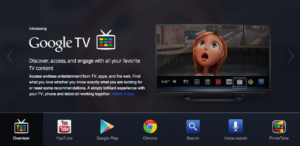
In the era of interconnected digital experiences, Google TV has introduced a groundbreaking feature that allows users to share movies and shows with a simple link. This move promises to redefine how we experience and talk about content with our friends and loved ones. Sharing content used to be cumbersome, involving long instructions or reliance on memory. But Google TV’s new feature streamlines this process. What makes this so special, and how does it impact user engagement and mobile app development services?
Google TV’s easy sharing capability isn’t just an innovation for users; it presents new opportunities for developers and content creators. By offering a simpler way to engage with entertainment, Google taps into a deep-rooted desire for social connection and communication. This article explores how this innovation enhances the streaming experience, shapes content discovery, and fuels app development strategies.
How Google TV’s New Sharing Feature Works
Google TV’s new feature makes sharing movies and shows as simple as sharing a link. When a user watches a movie or TV show they want to share, they generate a unique link to the content. The recipient clicks the link and is taken directly to the specific movie or show within Google TV.
The feature relies on integration across Google services, which means it not only provides seamless sharing but also respects platform restrictions. Sharing content from a mobile app to a TV, across platforms, or through text messages becomes intuitive. By removing steps and providing direct links, Google TV positions itself as a leader in creating a streamlined user experience.
Enhanced Content Discovery and Recommendations
With a simple link, Google TV users can now recommend their favorite shows and movies to friends and family. Word-of-mouth recommendations are a powerful driver of engagement. However, traditional recommendations involve tedious back-and-forth conversations.
When users can instantly share content links, recommendations become effortless, leading to faster content discovery. For mobile app development services focused on streaming platforms, there are numerous implications. Developers may now emphasize link-sharing capabilities and focus on building more social aspects around app interfaces.
Social Entertainment Meets Technology
Entertainment today is inherently social. Google TV’s feature recognizes and amplifies this reality by creating an ecosystem where sharing entertainment mimics everyday digital interactions. Users no longer have to rely solely on in-app recommendations; instead, they have agency over how they share their experience.
Social sharing integrates with other platforms, allowing easy posting on social media and direct messaging apps. This connectivity strengthens community engagement around content, which may translate to sustained user interest. Companies providing mobile app development services should take notice of this trend and explore how social-sharing tools can elevate their apps.
Impacts on User Engagement and Loyalty
User engagement is one of the most critical metrics for any platform or service. Google TV’s sharing feature has the potential to improve engagement rates by encouraging users to interact with one another directly within the platform. When users share content, they essentially act as brand advocates, boosting reach organically.
Moreover, increased sharing creates a feedback loop. Friends who engage with the recommended content can further share it with their own circles. As the network expands, Google TV becomes more than a viewing platform it transforms into a hub for shared experiences. Mobile app development services can capitalize on this trend by integrating social-sharing mechanisms that keep users within their ecosystems.
The Intersection of Convenience and Personalization
Convenience drives adoption, and the easier it is to access content, the more likely people will engage with it. Google TV’s link-sharing feature exemplifies convenience. When users can generate and share a link in seconds, they reduce barriers to entry for their friends, family, or colleagues. This instant gratification encourages users to engage more frequently.
In addition to convenience, there is an element of personalization. Recipients of a Google TV link can gain insight into their sender’s viewing preferences. Over time, this fosters deeper connections through shared content experiences, ultimately enhancing loyalty to the platform. Mobile app developers should consider similar personalization approaches for their apps to drive engagement.
Opportunities for Mobile App Developers
For mobile app development services, Google TV’s innovation offers inspiration and potential for strategic evolution. Integrating similar sharing capabilities can enhance apps across various categories, from e-learning and fitness to music and gaming. The goal is to make sharing content or progress as simple as tapping a button.
Developers can also explore other use cases, such as sharing in-game achievements, progress in educational courses, or favorite workout routines. By focusing on reducing friction, app developers will build deeper connections between their users and the apps they create.
Privacy Considerations in Content Sharing
While sharing content through Google TV is exciting, privacy concerns remain a critical consideration. Google has a robust framework for privacy and security; however, link-sharing features may have inherent risks if misused. It is essential to strike a balance between convenience and control.
Users must have options to revoke links, restrict access, or choose the type of information they wish to share. Mobile app development services need to remain vigilant, building features that consider user consent and privacy preferences. Transparency should always be the top priority.
The Broader Impact on Streaming Market Dynamics
In the competitive streaming market, features like Google TV’s link-sharing tool can influence market dynamics significantly. Platforms that innovate rapidly and deliver social features stand to gain a competitive edge over competitors. This is particularly true as viewers increasingly rely on recommendations from peers.
For mobile app development services, partnering with platforms and adopting similar social features may offer new avenues for growth. Sharing capabilities can help platforms build loyalty and differentiation, ultimately carving out their place in a saturated market.
Monetization Strategies for Content Sharing
Content sharing also presents monetization opportunities. When users share a movie or show link, they create a touchpoint for user acquisition. The shared link could lead recipients to subscription offers or free trials. This increases platform visibility while opening doors for new revenue streams.
For developers of mobile app development services, this also creates a pathway to offer monetization-focused integrations. Whether through affiliate sharing, promotional offers for shared content, or gamifying the sharing process, there are many creative ways to boost revenue while enhancing the user experience.
Real-Time Collaboration and Content Discussions
Beyond just sharing links, Google TV’s feature can facilitate real-time discussions and collaborations around the content. Imagine watching a show with a friend, miles apart, while sharing thoughts in real-time. With this new capability, that experience becomes much more fluid. As the recipient clicks the shared link, it becomes easier for both parties to stay in sync, discuss key moments, and connect over shared interests.
For mobile app developers, this presents another area for innovation. Real-time communication features, such as chat options or reactions, can deepen user engagement. Apps that encourage interaction and collaboration create a community around the content and offer additional touchpoints for engagement.
Integrating Shared Viewing with AI-Driven Insights
Google TV’s sharing feature could open up even more possibilities with AI-driven personalization. For example, sharing habits and viewing patterns can help Google’s algorithms better understand user preferences. This data could then be leveraged to refine recommendations, offering personalized content suggestions based on what friends and family share most.
Mobile app development services should note that such AI-driven insights can enhance personalization, creating a more user-centric experience. By tapping into user data responsibly, developers can build apps that offer highly relevant content, predict user interests, and keep audiences engaged.
User Experience and Streamlined Workflows
User experience (UX) is always a key driver of success in the digital world. Google TV’s link-sharing feature makes the process of sharing intuitive and reduces friction. The simpler the UX, the more likely users are to engage repeatedly with the platform.
Mobile app development services can look at this as a case study on how streamlined workflows drive user retention. Minimizing steps in a process, automating where possible, and providing direct, fast access to features ultimately leads to better adoption rates. Every app creator should strive to simplify complex actions in their apps and prioritize UX that removes friction.
The Future of Cross-Device Sharing
Another interesting aspect of Google TV’s sharing capability is its ability to integrate across devices. Cross-device compatibility has become essential as users now engage with content on TVs, smartphones, tablets, and more. Google TV ensures that users can start watching on one device and share a link that works seamlessly on another.
For developers and mobile app development services, there are lessons to be learned. Creating cross-platform compatibility that bridges experiences between mobile devices, tablets, and TVs ensures more touchpoints and higher user engagement. This kind of seamless integration makes it easier for users to stick with a platform.
Leveraging Analytics to Measure Sharing Impact
When users share content, valuable analytics can be derived from their behavior. How often do users share? Which types of content resonate most with certain demographics? How does shared content influence new user acquisition? Google TV’s feature could offer important data points to answer such questions.
Mobile app developers can employ analytics-driven approaches to measure the impact of their features, identify trends, and continuously optimize apps for performance and user satisfaction. Metrics around social sharing, link engagement, and referrals are invaluable for guiding marketing strategies and enhancing app functionalities.
Challenges and Future Improvements
No feature is without its challenges. While Google TV’s link-sharing functionality is innovative, developers must remain aware of potential issues such as spam, misuse, or overwhelming notifications. User control over how and when links can be shared will be key to maintaining a positive experience. Additionally, app development costs can escalate as developers work to integrate robust spam prevention mechanisms, customizable sharing controls, and user-friendly notification settings that enhance security and user satisfaction.
In the future, we may see Google refine the process even further, offering better customization options, content filtering, and additional security measures. Developers building mobile app services should always anticipate these challenges and proactively introduce features and controls that address user concerns.
Conclusion
The new link-sharing capability in Google TV is more than a simple update; it’s a shift in how users engage with content and connect with each other. By making sharing as simple as clicking a link, Google TV has tapped into the power of social interaction and content-driven relationships. For mobile app development services, it opens doors for innovation in app design, engagement strategies, monetization, and privacy controls. As users continue to demand social features that enrich their experiences, the lesson here is clear: simplicity drives connection. In the future, the platforms that focus on making connections easier will define the next era of digital engagement.


